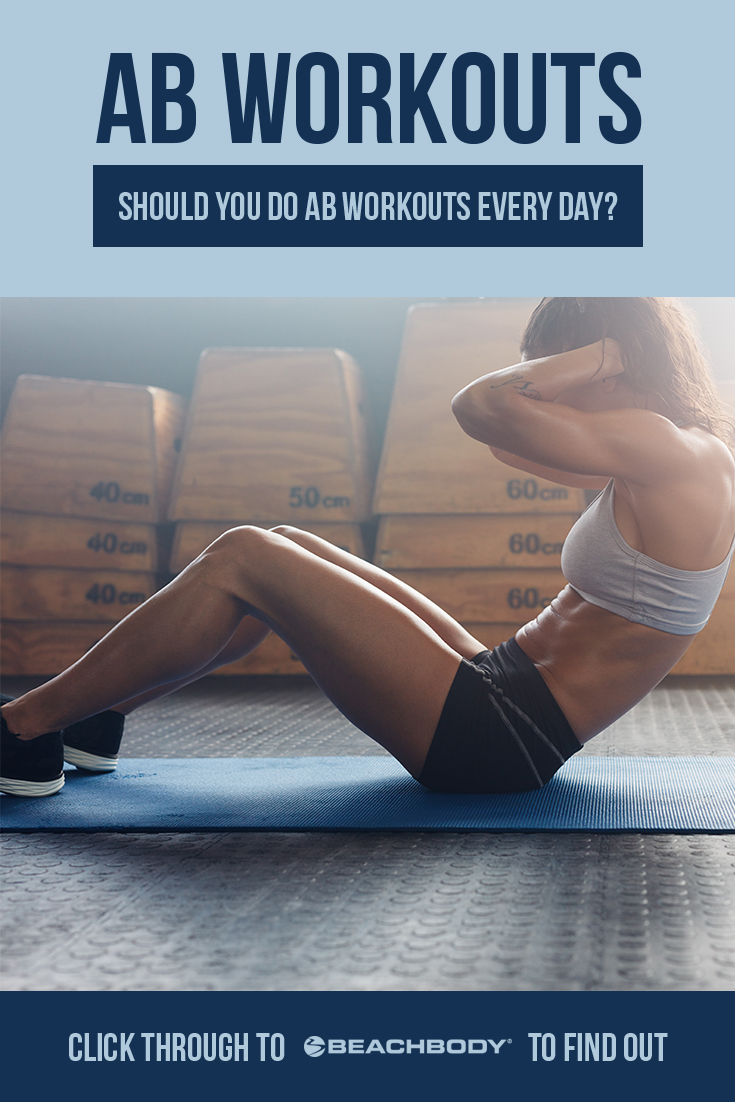Should You Do Ab Workouts Every Day?

Veteran lifters avoid hammering their quads, hamstrings, or pecs every day, because if all you do is break your muscles down, they’ll never have time to recover.
The same goes for doing a daily ab workout.
Our abs help form the bridge between our upper and lower bodies, keeping us together and upright all day long.
So there’s a commonly held idea that they’re “endurance muscles” unconstrained by the immutable laws of hypertrophy.
But that notion isn’t widely shared by members of the fitness establishment, several of whom we surveyed for their opinions on the value of doing a daily ab workout.
The most neutral opinion comes from Alex Koch, professor of health, exercise and sports science at Lenoir-Rhyne University in Hickory, North Carolina.
“You can exercise abs daily, but I personally don’t recommend it,” he says.
In his opinion, abdominals are essentially just like any other muscles, so to make them bigger and stronger he recommends targeting them about twice a week.
Rob Sulaver, CEO and Founder of Bandana Training, adds that the muscle fiber makeup of our abs tells us that they shouldn’t be trained every day.
“Our rectus abdominis is roughly equal parts fast- and slow-twitch muscle fiber, just like our arms and thighs,” he says. “With proper training, they’ll need time to recover.”
Can You Overtrain Abs?
Overtraining involves overloading your muscles, joints, and/or nervous system excessively, a condition to which your abs aren’t immune.
“If you work your abs hard enough, you’ll feel the work you did the day before, and you’ll agree you need to rest them,” says New York City trainer Dominique Hall.
How Often Should You Train Abs?

Hall recommends targeting your abs every other day at most to allow them adequate time to recover.
If you can’t tell whether you’ve worked your abs sufficiently, she has a suggestion: “Tracking your workouts and being consistent about your routine motivates you to do better each time.”
“The more you improve on those numbers, the more muscle you build and bam, you’ll see a six-pack!” (Provided you’ve shed enough body fat, of course.)
The Role of Diet Vs. Exercise in Getting Abs
Building visible abs is a two-front war, with eating and activity demanding equal attention.
“People think you can outwork a bad diet, but they’re fooling themselves,” says Hall. “You do need to work your abs, but don’t forget your food intake has to [complement] your goals,” she adds.
In short, dial in your diet or your six-pack will never reveal itself.
Emphasize fiber and protein, avoid refined and processed carbs, don’t skip meals, and do drink copious amounts of water.
It also won’t hurt to cut down on liquor, which can interfere with your body’s metabolization of nutrients from food.
9 Exercises for Your Next Ab Workout
When you do target your abs, work in a few of these moves from Beachbody programs to diversify your routine.
1. Plank jack (600 Secs)
- Start in forearm plank with your elbows under your shoulders and your body in a straight line from head to heels.
- At the same time, jump both legs out to the side, and then back together. Keep hips stable so they don’t drop or lift up.
- Make this move easier by performing it in a high-plank position, or doing the plank side foot taps exercise (above).
2. Mountain climber (T-MINUS 30)
- Start in a high-plank position.
- Engage your core to pull your right knee in toward your chest so your foot hovers above the ground, and then step back into the plank. Repeat on the other side with your left leg.
- Speed it up, alternating one leg in and then the other.
- Be sure to keep your hips level and fully extend each leg as it comes back out from the center.
3. Russian twist (Rough Around the Edges)
- Sit on the ground, balancing on your tailbone with your knees bent about 90 degrees, heels on the ground and feet flexed. Hold your hands together in front of your torso.
- Twist to your right side, bringing your hands down toward your right hip. Then, reverse the moves and twist to your left side.
- Make it extra challenging by speeding it up, lifting your feet off the ground, or holding a light weight in your hands (shown in video above).
4. Boat Pose (Yoga52)
- Sit on a yoga mat, with your feet flat on the floor, hip-width apart.
- Keeping your spine straight (don’t let it round!) and your abs engaged, find your balance by leaning back between your sitting bones and tailbone.
- Lift your feet so your shins are parallel with your mat. Then, if possible, straighten your knees so your legs form a 45-degree angle with the floor.
- Extend your arms in front of you, with your palms facing in and your shoulders away from your ears.
- Hold the pose for five breaths up to one minute.
5. Bicycle twist (600 Secs)
- Lay on your back with your legs out straight. Lightly place your hands on the back of your head with your elbows pointed out to the sides.
- Keeping your lower back on the ground, engage your core to lift your chest up and bring your right knee in toward your chest as you rotate your torso to bring your left elbow toward your right knee.
- Reverse the move by straightening your right leg as you bend your left leg and bring it in toward your chest as you rotate your torso to bring your right elbow toward your left knee.
- Once you have the right form down, begin to move faster to ramp up the cardio element of this move.
6. Bear crawl (T-MINUS 30)
- Begin on your hands and feet with your hands under your shoulders and your knees bent to a 90-degree angle below your hips. Hover your knees a few inches above the ground.
- Keeping your back flat and your core engaged, start to crawl forward by moving your left hand and right foot simultaneously, and then your right hand and left foot simultaneously. Don’t let your hips dip or raise.
- Continue crawling forward with opposite hands and feet in unison. Then, reverse the move to crawl backward for the same number of steps.
7. Dolphin hop (Rough Around the Edges)
- Start in forearm plank with your feet together.
- Lift your hips and hop your feet toward your arms in three small bursts.
- Pause at the top with your hips lifted high, and then step back into the starting plank position.
- Repeat, hopping in a sequence of three hops forward, then step back.
8. Scissor kicks (T-MINUS 30)
- Lie on your back with your arms down by your sides.
- Lift both of your legs a few inches off the ground and separate them slightly into a “V” shape. Engage your core and press your lower back into the floor.
- Keeping both legs straight, bring your legs together and cross your right leg over the left. Widen your legs into a “V” again, and then bring your legs together again, this time crossing your left leg over the right.
- Continue alternating until you’ve completed all reps.
- Always keep your lower back pressed into the floor. If it starts to arch, lift your legs up to reduce tension on your core.
9. Core row (Rough Around the Edges)
- Balancing on your tailbone, reach your arms straight forward and lift your feet off the ground with your legs bent.
- Keeping your core engaged and spine straight, bend your elbows to pull your hands toward your chest with your elbows pointed out to the side (as if you were rowing a boat). At the same time, extend your legs out in front of you without letting your feet touch the ground.
- Return to the starting position by reaching your arms forward and bending your knees back into your chest. Repeat for reps.
Mixing Up Your Routine Is a Good Idea
Rilinger says that instead of spending 10 to 15 minutes doing crunches, you could try doing some full-body, high-intensity interval (HIIT) training instead.
“You will be be burning more calories, and abs are only seen when you are lean,” she says.
Hall agrees that mixing it up is a good policy. “People think that crunches are the only effective ab exercises,” she says. “Sprints, doing high knees while jumping rope, and doing a front squat are other ways to work your abs. By doing these movements, you can stimulate your abs in different ways on an almost daily basis — but doing the same ab exercises everyday will only bring you injury down the road.”

